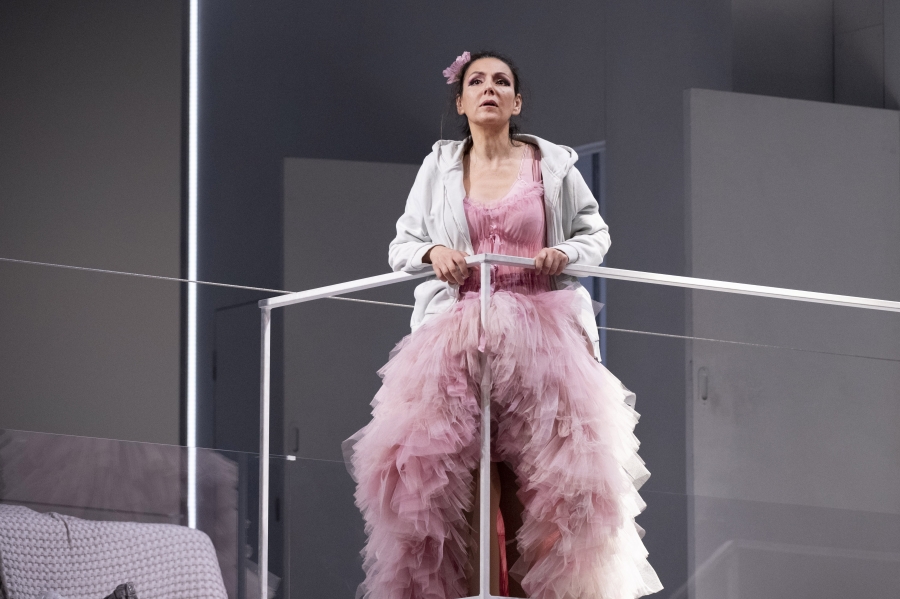
There is plenty of tricky ground to tread when bringing Madam Butterfly to the stage. One of Puccini’s masterwork, the opera is so well-known, even within the broader boundaries of pop culture, that it is a challenge in itself to approach it from a new angle, without repeating something that has already been done to exhaustion while at the same time avoiding the temptation of adding something bizarre for the mere sake of novelty. Then there’s the themes: a depiction of Japan and Japanese culture in the original text which, while sympathetic, is far from accurate; a tale of exploitation with a young teenager at its centre; a condemnation of imperialism, and American imperialism specifically, which may resonate surprisingly close to our sensitivities in the present day. Everybody knows Butterfly, but how many dare do Butterfly? Among the brave is this WNO production, which chooses as its focus the human dimension of the story, its universal value, placing an emphasis on the private feelings of the characters.
It does so first and foremost through its staging, one of the most striking traits of this production: all straight lines, white spaces, and neon lights, the space of the story looks like a non-place located in a non-time, something almost dystopian, reminiscent of The Matrix or, perhaps most aptly, The Handmaid’s Tale. It is an effective visual device, and the way the space is used is ingenious, too, with the spinning house at the centre of the scene revealing as it moves different angles and therefore the different interpretations that go with them, in a subtle form of non-verbal commentary. The downside of this level of abstraction is, however, that it inevitably sacrifices one layer of the text: inaccurate as its depiction of Japan it might be, Puccini’s Butterfly is first and foremost a scathing comment passed on imperialism, on the way that the Americans characters view the Japanese ones as commodities and curiosities rather than people, worthy in the best case of pity, but not of real affection; in the worst case, to be discarded without a second thought. With the American anthem openly woven into Puccini’s music, resurfacing ominously and sounding more and more threatening as the story unfolds, Butterfly is a condemnation of imperialistic attitudes in a specific time and place, and choosing to abstract from it, while a cautious choice, lessens somewhat its impact as a merciless comment on colonial attitude.
Alexia Voulgaridou and Kezia Bienek
Alexia Voulgaridou and Leonardo Caimi
Gareth Brynmor John and Alexia Voulgaridou
Yet this does not compromise the impact of the production overall, as what remains is a deeply human drama, with emotional performances which spare the audience nothing of the heavy, stark feelings they confront. Imperialism or no, Butterfly’s story is one of abuse, and of a woman trapped within an abusive system. Alexia Voulgaridou does an excellent job of conveying both the character’s helplessness and her emotional strength, her proud refusal to comply with the will of those who would silence her. Yet the strongest female presence on stage is perhaps that of Kezia Bienek’s Suzuki, emotional and empathetic, imposing and kind at the same time, a truly stand-out performance. On the other side of the divide, Leonardo Caimi’s Pinkerton strikes the difficult balance of charming and despicable which is the only way of making the character work; Tom Randle’s Goro is suitably slimy; and Gareth Brynmor John shines in his tackling of the complicated part that is Sharpless, with all his contradictions, his failing immediately short of being a sympathetic character, his second-guessing and his ultimate cowardice. The supporting cast deserves praise too, in the way that they animate the almost sanitised scenery, filling it with human presences which are a counterpoint to the very human dimension of the tragedy.
Then there is all the rest, the things that Butterfly is famous for; the minutiae of the weaving of its soundscape, the little suggestions that grow and return and bloom into themes, the famous aria, delivered by Voulgaridou with a rounded vocal performance and a compelling depth of emotion; the inevitable pull of feeling that the story has, touching upon delicate chords and forcing the audience to confront the discomfort and the disquiet which come with it. This too is preserved in the WNO production, even though there is in places a detachment, in which it feels like watching from the outside, as if the story was happening in an aquarium; this is not a negative, though, as the detachment itself makes the punch, in the end, land even harder.
It could be argued that boiling Butterfly down to the human component of the tragedy is a lost occasion to confront the relevance of its more political themes; perhaps to an extent this is true. But to bring a classic to the scene is also to strive to look at it from an innovative angle, and this is certainly a way of doing so that doesn’t feel forced or contrived. It is a bringing to life of Puccini’s work in a new skin, and that is ultimately a goal any production of such a classic should aim for.
Main image: Alexia Voulgaridou and Kezia Bienek
Images Clive Barda.
Wales Millennium Centre until March 19 and touring until May 14.
wno.org.uk


